Economic Assignment: Unemployment Trends in the Australian Economy
VerifiedAdded on 2021/05/27
|14
|3520
|54
Report
AI Summary
This economic assignment provides a detailed analysis of the Australian labor market, focusing on unemployment trends and various contributing factors. The report begins with an introduction to the importance of labor market performance as a key macroeconomic indicator, highlighting the consequences of unemployment such as poverty and its impact on economic growth. It then delves into the types of unemployment prevalent in Australia, including cyclical, structural, and frictional unemployment, with an emphasis on the structural mismatch and business cycle contractions. The report presents data on unemployment rates from 2013 to 2018, including fluctuations and specific statistics on employment figures, labor force participation, and the impact of the mining sector. Furthermore, it examines youth unemployment and its severity in Australia, comparing it to overall unemployment rates and highlighting regional disparities. Gender-based unemployment differences and the influence of immigration on the labor market are also explored, with an emphasis on part-time employment and the underutilization of the female labor force. The report concludes with a discussion on the overall trends and implications of unemployment in the Australian economy.

Running Head: ECONOMIC ASSIGNMENT
Economic Assignment
Name of the Student
Name of the University
Course ID
Economic Assignment
Name of the Student
Name of the University
Course ID
Paraphrase This Document
Need a fresh take? Get an instant paraphrase of this document with our AI Paraphraser
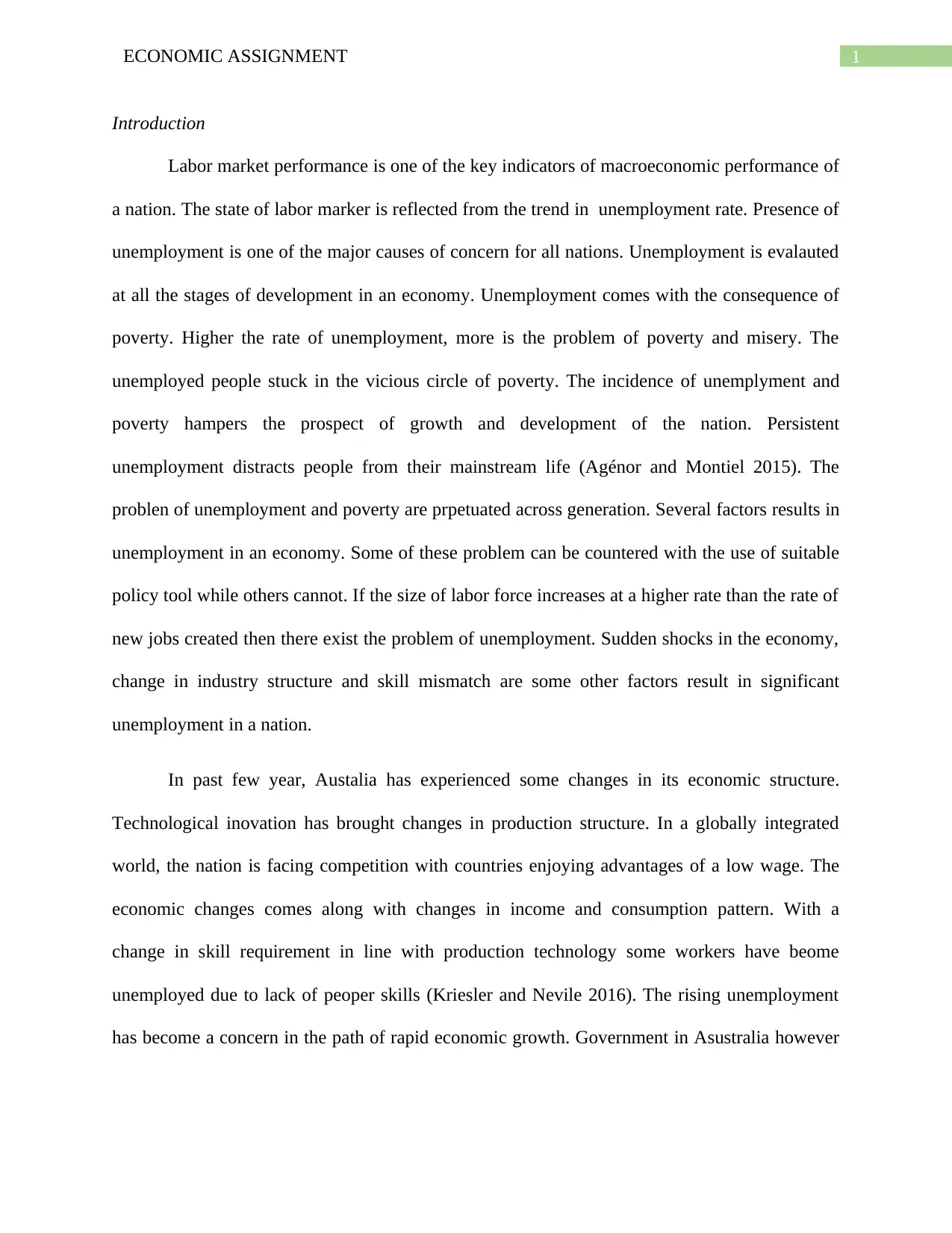
1ECONOMIC ASSIGNMENT
Introduction
Labor market performance is one of the key indicators of macroeconomic performance of
a nation. The state of labor marker is reflected from the trend in unemployment rate. Presence of
unemployment is one of the major causes of concern for all nations. Unemployment is evalauted
at all the stages of development in an economy. Unemployment comes with the consequence of
poverty. Higher the rate of unemployment, more is the problem of poverty and misery. The
unemployed people stuck in the vicious circle of poverty. The incidence of unemplyment and
poverty hampers the prospect of growth and development of the nation. Persistent
unemployment distracts people from their mainstream life (Agénor and Montiel 2015). The
problen of unemployment and poverty are prpetuated across generation. Several factors results in
unemployment in an economy. Some of these problem can be countered with the use of suitable
policy tool while others cannot. If the size of labor force increases at a higher rate than the rate of
new jobs created then there exist the problem of unemployment. Sudden shocks in the economy,
change in industry structure and skill mismatch are some other factors result in significant
unemployment in a nation.
In past few year, Austalia has experienced some changes in its economic structure.
Technological inovation has brought changes in production structure. In a globally integrated
world, the nation is facing competition with countries enjoying advantages of a low wage. The
economic changes comes along with changes in income and consumption pattern. With a
change in skill requirement in line with production technology some workers have beome
unemployed due to lack of peoper skills (Kriesler and Nevile 2016). The rising unemployment
has become a concern in the path of rapid economic growth. Government in Asustralia however
Introduction
Labor market performance is one of the key indicators of macroeconomic performance of
a nation. The state of labor marker is reflected from the trend in unemployment rate. Presence of
unemployment is one of the major causes of concern for all nations. Unemployment is evalauted
at all the stages of development in an economy. Unemployment comes with the consequence of
poverty. Higher the rate of unemployment, more is the problem of poverty and misery. The
unemployed people stuck in the vicious circle of poverty. The incidence of unemplyment and
poverty hampers the prospect of growth and development of the nation. Persistent
unemployment distracts people from their mainstream life (Agénor and Montiel 2015). The
problen of unemployment and poverty are prpetuated across generation. Several factors results in
unemployment in an economy. Some of these problem can be countered with the use of suitable
policy tool while others cannot. If the size of labor force increases at a higher rate than the rate of
new jobs created then there exist the problem of unemployment. Sudden shocks in the economy,
change in industry structure and skill mismatch are some other factors result in significant
unemployment in a nation.
In past few year, Austalia has experienced some changes in its economic structure.
Technological inovation has brought changes in production structure. In a globally integrated
world, the nation is facing competition with countries enjoying advantages of a low wage. The
economic changes comes along with changes in income and consumption pattern. With a
change in skill requirement in line with production technology some workers have beome
unemployed due to lack of peoper skills (Kriesler and Nevile 2016). The rising unemployment
has become a concern in the path of rapid economic growth. Government in Asustralia however

2ECONOMIC ASSIGNMENT
designes different schemes to promote employment opportunities and maintain rate of
unemployment as low as possible.
Unemployment in Australia
Cyclical, structural and frictional are some of the common form of unemployment.
Structural and frictional unemplyment fall under the category of economy’s natural rate of
unemployment. The natural rate of unemployment indicates the rate of unemployment that is
always in existence in an economy. Cyclical unemployment relates with fluctuation in business
cycle. Rate of unemployment varies with stages of business cycle. In times of economic
expansion, output expands leading to new job opportunities and hence a lower rate of
unemplyment. During recession on the other hand the economy contracts (Kennedy and Prag
2017). This leads to job losses and hence a higher rate of unemployment. In the process of
development, different industries undergo some changes. The changes most often come along
with changes in skill requirement. Unemployment caused by structural mismatch is termed as
structural unemployment. Frictional unemployment is one that exists in the period of transition
from one industry to another. If problem of unemployment persists for a long period of time (six
months or more) then unemployment is viewed as a long term phenomenon.
In Ausralia unemployment exists for various reasons. Rate of unemployment in 2011 was
recorded as 5.75 pecent (Scott 2015). The unemployment in Australia is mostly resulted from
structural mismatch and business cycle contraction. Mining sector is one important contributor
for Australian economy. As the sector employs a number of people expansion and contraction of
the single sector has significant influence for the rate of unemployment. The mining sector has
faced a period of contraction in the last few years. The decline in investment in the sector along
with gloomy propects of mining projects results in a decline in labor demand. The excess supply
designes different schemes to promote employment opportunities and maintain rate of
unemployment as low as possible.
Unemployment in Australia
Cyclical, structural and frictional are some of the common form of unemployment.
Structural and frictional unemplyment fall under the category of economy’s natural rate of
unemployment. The natural rate of unemployment indicates the rate of unemployment that is
always in existence in an economy. Cyclical unemployment relates with fluctuation in business
cycle. Rate of unemployment varies with stages of business cycle. In times of economic
expansion, output expands leading to new job opportunities and hence a lower rate of
unemplyment. During recession on the other hand the economy contracts (Kennedy and Prag
2017). This leads to job losses and hence a higher rate of unemployment. In the process of
development, different industries undergo some changes. The changes most often come along
with changes in skill requirement. Unemployment caused by structural mismatch is termed as
structural unemployment. Frictional unemployment is one that exists in the period of transition
from one industry to another. If problem of unemployment persists for a long period of time (six
months or more) then unemployment is viewed as a long term phenomenon.
In Ausralia unemployment exists for various reasons. Rate of unemployment in 2011 was
recorded as 5.75 pecent (Scott 2015). The unemployment in Australia is mostly resulted from
structural mismatch and business cycle contraction. Mining sector is one important contributor
for Australian economy. As the sector employs a number of people expansion and contraction of
the single sector has significant influence for the rate of unemployment. The mining sector has
faced a period of contraction in the last few years. The decline in investment in the sector along
with gloomy propects of mining projects results in a decline in labor demand. The excess supply
⊘ This is a preview!⊘
Do you want full access?
Subscribe today to unlock all pages.

Trusted by 1+ million students worldwide

3ECONOMIC ASSIGNMENT
of labor leads to unemployment in the economy. This type of unemployment has beome more
relevant for male members of labor force being engaged in the mining sector by a larger
proportion. Frictional unemployment is Australia has resulted from transition of workers from
one industry to another. Recently, the economy of Australia has come under severe pressure of
youth unemployment and long term unemployment (Gregory and Smith 2016). People in
Australia are unemployed for a period between 4 and 52 weeks. In the unemployment trend,
cyclical fluctuation plays an important role.
Figure 1: Unemployment trend in last five years
(Source: tradingeconomics.com 2018)
In the last five years the unemployment trend in Australa has experienced a dramatic
fluctuation. For the yeat 2013, unemployment had accounted a modest decrease by 0.1 percent.
In the third quarter of 2013, unemployment stood at 5.6%. Statistics show that number of
unemployed people decreased by 14,700 and become 697,100. The labor force participation rate
however accounted a slight decline by 0.1 percentage point. With this, the seasonally adjusted
labor force particiaption rate became 64.9% (jobs.gov.au 2018). Associated with this the nuber
of labor leads to unemployment in the economy. This type of unemployment has beome more
relevant for male members of labor force being engaged in the mining sector by a larger
proportion. Frictional unemployment is Australia has resulted from transition of workers from
one industry to another. Recently, the economy of Australia has come under severe pressure of
youth unemployment and long term unemployment (Gregory and Smith 2016). People in
Australia are unemployed for a period between 4 and 52 weeks. In the unemployment trend,
cyclical fluctuation plays an important role.
Figure 1: Unemployment trend in last five years
(Source: tradingeconomics.com 2018)
In the last five years the unemployment trend in Australa has experienced a dramatic
fluctuation. For the yeat 2013, unemployment had accounted a modest decrease by 0.1 percent.
In the third quarter of 2013, unemployment stood at 5.6%. Statistics show that number of
unemployed people decreased by 14,700 and become 697,100. The labor force participation rate
however accounted a slight decline by 0.1 percentage point. With this, the seasonally adjusted
labor force particiaption rate became 64.9% (jobs.gov.au 2018). Associated with this the nuber
Paraphrase This Document
Need a fresh take? Get an instant paraphrase of this document with our AI Paraphraser
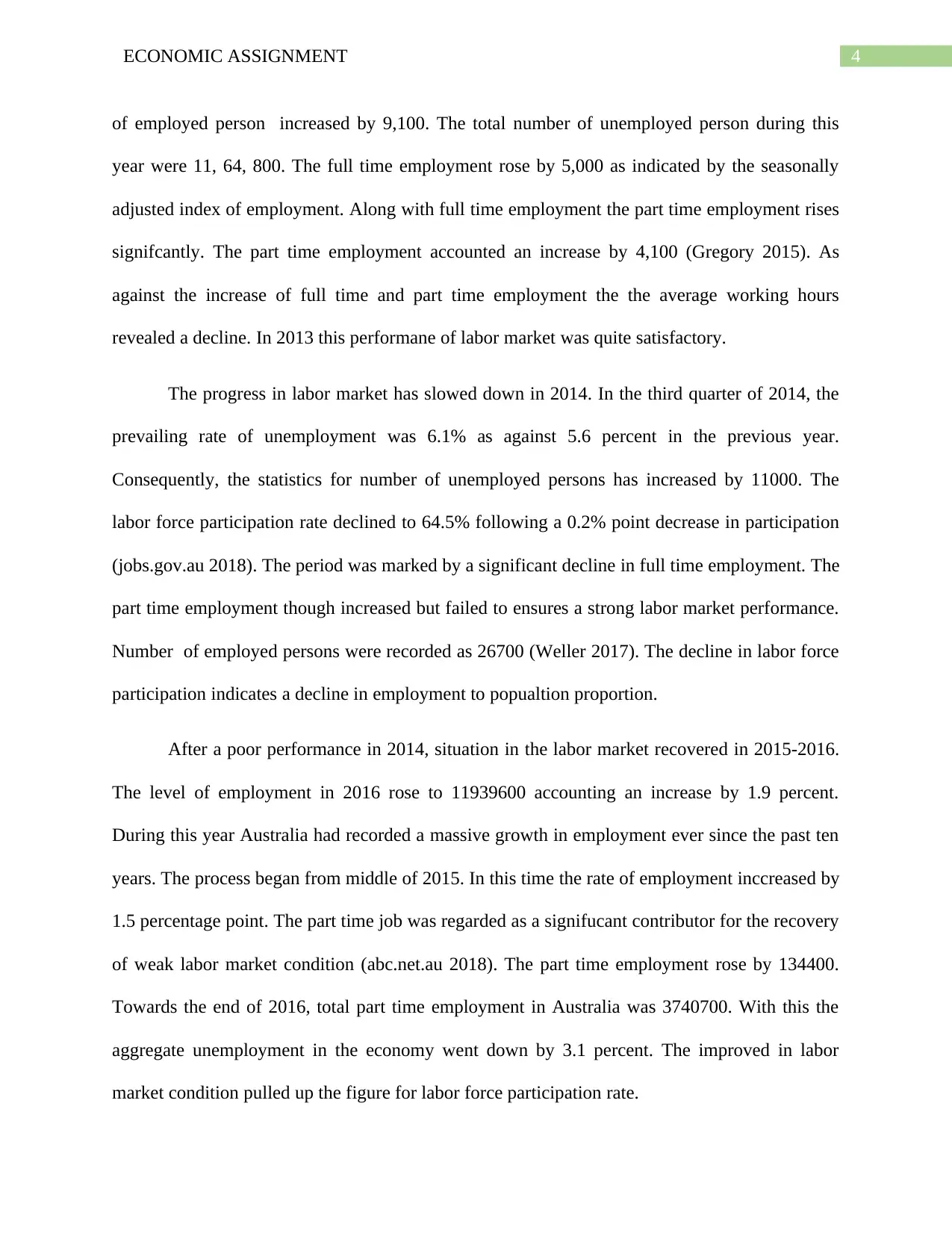
4ECONOMIC ASSIGNMENT
of employed person increased by 9,100. The total number of unemployed person during this
year were 11, 64, 800. The full time employment rose by 5,000 as indicated by the seasonally
adjusted index of employment. Along with full time employment the part time employment rises
signifcantly. The part time employment accounted an increase by 4,100 (Gregory 2015). As
against the increase of full time and part time employment the the average working hours
revealed a decline. In 2013 this performane of labor market was quite satisfactory.
The progress in labor market has slowed down in 2014. In the third quarter of 2014, the
prevailing rate of unemployment was 6.1% as against 5.6 percent in the previous year.
Consequently, the statistics for number of unemployed persons has increased by 11000. The
labor force participation rate declined to 64.5% following a 0.2% point decrease in participation
(jobs.gov.au 2018). The period was marked by a significant decline in full time employment. The
part time employment though increased but failed to ensures a strong labor market performance.
Number of employed persons were recorded as 26700 (Weller 2017). The decline in labor force
participation indicates a decline in employment to popualtion proportion.
After a poor performance in 2014, situation in the labor market recovered in 2015-2016.
The level of employment in 2016 rose to 11939600 accounting an increase by 1.9 percent.
During this year Australia had recorded a massive growth in employment ever since the past ten
years. The process began from middle of 2015. In this time the rate of employment inccreased by
1.5 percentage point. The part time job was regarded as a signifucant contributor for the recovery
of weak labor market condition (abc.net.au 2018). The part time employment rose by 134400.
Towards the end of 2016, total part time employment in Australia was 3740700. With this the
aggregate unemployment in the economy went down by 3.1 percent. The improved in labor
market condition pulled up the figure for labor force participation rate.
of employed person increased by 9,100. The total number of unemployed person during this
year were 11, 64, 800. The full time employment rose by 5,000 as indicated by the seasonally
adjusted index of employment. Along with full time employment the part time employment rises
signifcantly. The part time employment accounted an increase by 4,100 (Gregory 2015). As
against the increase of full time and part time employment the the average working hours
revealed a decline. In 2013 this performane of labor market was quite satisfactory.
The progress in labor market has slowed down in 2014. In the third quarter of 2014, the
prevailing rate of unemployment was 6.1% as against 5.6 percent in the previous year.
Consequently, the statistics for number of unemployed persons has increased by 11000. The
labor force participation rate declined to 64.5% following a 0.2% point decrease in participation
(jobs.gov.au 2018). The period was marked by a significant decline in full time employment. The
part time employment though increased but failed to ensures a strong labor market performance.
Number of employed persons were recorded as 26700 (Weller 2017). The decline in labor force
participation indicates a decline in employment to popualtion proportion.
After a poor performance in 2014, situation in the labor market recovered in 2015-2016.
The level of employment in 2016 rose to 11939600 accounting an increase by 1.9 percent.
During this year Australia had recorded a massive growth in employment ever since the past ten
years. The process began from middle of 2015. In this time the rate of employment inccreased by
1.5 percentage point. The part time job was regarded as a signifucant contributor for the recovery
of weak labor market condition (abc.net.au 2018). The part time employment rose by 134400.
Towards the end of 2016, total part time employment in Australia was 3740700. With this the
aggregate unemployment in the economy went down by 3.1 percent. The improved in labor
market condition pulled up the figure for labor force participation rate.
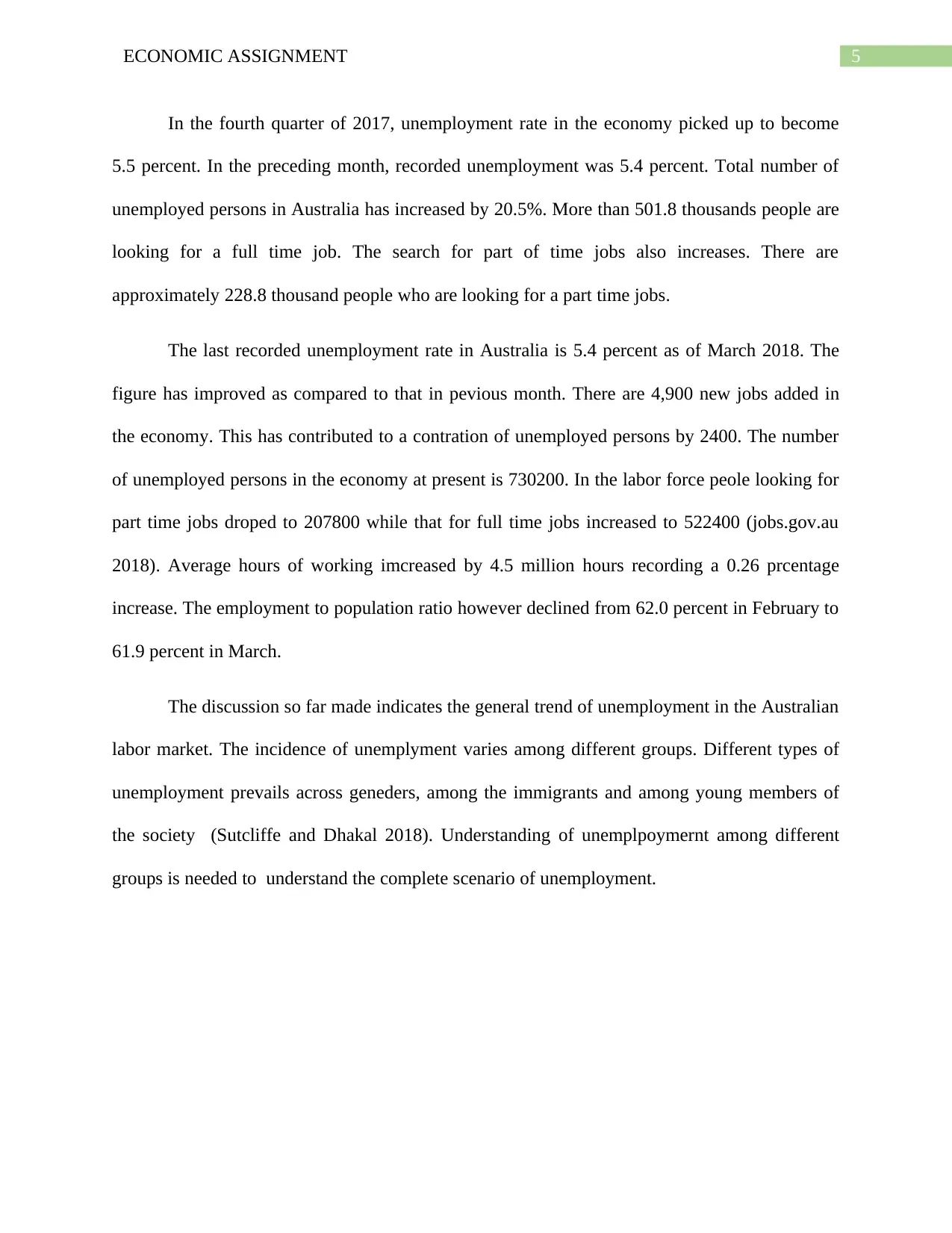
5ECONOMIC ASSIGNMENT
In the fourth quarter of 2017, unemployment rate in the economy picked up to become
5.5 percent. In the preceding month, recorded unemployment was 5.4 percent. Total number of
unemployed persons in Australia has increased by 20.5%. More than 501.8 thousands people are
looking for a full time job. The search for part of time jobs also increases. There are
approximately 228.8 thousand people who are looking for a part time jobs.
The last recorded unemployment rate in Australia is 5.4 percent as of March 2018. The
figure has improved as compared to that in pevious month. There are 4,900 new jobs added in
the economy. This has contributed to a contration of unemployed persons by 2400. The number
of unemployed persons in the economy at present is 730200. In the labor force peole looking for
part time jobs droped to 207800 while that for full time jobs increased to 522400 (jobs.gov.au
2018). Average hours of working imcreased by 4.5 million hours recording a 0.26 prcentage
increase. The employment to population ratio however declined from 62.0 percent in February to
61.9 percent in March.
The discussion so far made indicates the general trend of unemployment in the Australian
labor market. The incidence of unemplyment varies among different groups. Different types of
unemployment prevails across geneders, among the immigrants and among young members of
the society (Sutcliffe and Dhakal 2018). Understanding of unemplpoymernt among different
groups is needed to understand the complete scenario of unemployment.
In the fourth quarter of 2017, unemployment rate in the economy picked up to become
5.5 percent. In the preceding month, recorded unemployment was 5.4 percent. Total number of
unemployed persons in Australia has increased by 20.5%. More than 501.8 thousands people are
looking for a full time job. The search for part of time jobs also increases. There are
approximately 228.8 thousand people who are looking for a part time jobs.
The last recorded unemployment rate in Australia is 5.4 percent as of March 2018. The
figure has improved as compared to that in pevious month. There are 4,900 new jobs added in
the economy. This has contributed to a contration of unemployed persons by 2400. The number
of unemployed persons in the economy at present is 730200. In the labor force peole looking for
part time jobs droped to 207800 while that for full time jobs increased to 522400 (jobs.gov.au
2018). Average hours of working imcreased by 4.5 million hours recording a 0.26 prcentage
increase. The employment to population ratio however declined from 62.0 percent in February to
61.9 percent in March.
The discussion so far made indicates the general trend of unemployment in the Australian
labor market. The incidence of unemplyment varies among different groups. Different types of
unemployment prevails across geneders, among the immigrants and among young members of
the society (Sutcliffe and Dhakal 2018). Understanding of unemplpoymernt among different
groups is needed to understand the complete scenario of unemployment.
⊘ This is a preview!⊘
Do you want full access?
Subscribe today to unlock all pages.

Trusted by 1+ million students worldwide

6ECONOMIC ASSIGNMENT
Figure 2: Youth Unemployment in Australia
(Source: businessinsider.com.au 2018)
The most serious concern for an economy is youth unemployment. In Australia, the
young members of the labor force are unable to find suitable jobs. After the hit of Global
Financial Crisis, the labor market was affected significantly. Among them the condition of youth
was worst. People aged between 15 amd 24 found it really hard to have a sutitable job. In 2014,
the recorded youth unemployment was 14.5 percent (Carvalho 2015). During this year, for youth
belonging to age group 15 to 24, the unemployment rate was stood around a rate of 15 percent.
This was the time when Australain youth faced a serious problem in finding any jobs. In the total
labor force, the proportiom of young member has declined gradually. This indicates a relatively
smaller youth participation rate in the labor market. At the beginning of fourth quarter of 2017,
youth unemployment rate declined by 0.1 percentage point to rach 12.30% from 12.40% in the
preceeding month. The average youth unemployment is much higher as compared to overall
unempoyment in the nation. From 1978 to 2018, the average unemployment in Australia is 6.88
Figure 2: Youth Unemployment in Australia
(Source: businessinsider.com.au 2018)
The most serious concern for an economy is youth unemployment. In Australia, the
young members of the labor force are unable to find suitable jobs. After the hit of Global
Financial Crisis, the labor market was affected significantly. Among them the condition of youth
was worst. People aged between 15 amd 24 found it really hard to have a sutitable job. In 2014,
the recorded youth unemployment was 14.5 percent (Carvalho 2015). During this year, for youth
belonging to age group 15 to 24, the unemployment rate was stood around a rate of 15 percent.
This was the time when Australain youth faced a serious problem in finding any jobs. In the total
labor force, the proportiom of young member has declined gradually. This indicates a relatively
smaller youth participation rate in the labor market. At the beginning of fourth quarter of 2017,
youth unemployment rate declined by 0.1 percentage point to rach 12.30% from 12.40% in the
preceeding month. The average youth unemployment is much higher as compared to overall
unempoyment in the nation. From 1978 to 2018, the average unemployment in Australia is 6.88
Paraphrase This Document
Need a fresh take? Get an instant paraphrase of this document with our AI Paraphraser
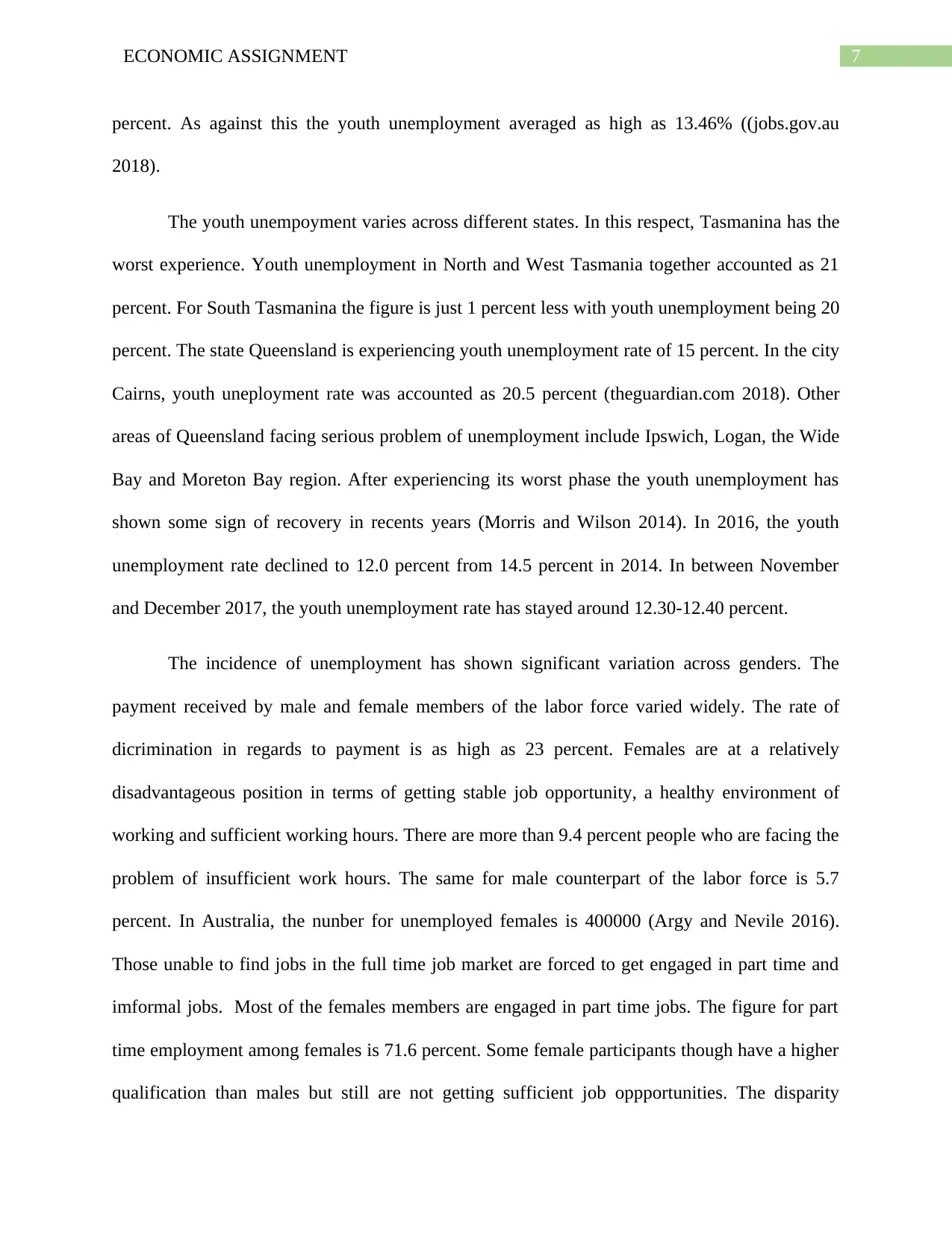
7ECONOMIC ASSIGNMENT
percent. As against this the youth unemployment averaged as high as 13.46% ((jobs.gov.au
2018).
The youth unempoyment varies across different states. In this respect, Tasmanina has the
worst experience. Youth unemployment in North and West Tasmania together accounted as 21
percent. For South Tasmanina the figure is just 1 percent less with youth unemployment being 20
percent. The state Queensland is experiencing youth unemployment rate of 15 percent. In the city
Cairns, youth uneployment rate was accounted as 20.5 percent (theguardian.com 2018). Other
areas of Queensland facing serious problem of unemployment include Ipswich, Logan, the Wide
Bay and Moreton Bay region. After experiencing its worst phase the youth unemployment has
shown some sign of recovery in recents years (Morris and Wilson 2014). In 2016, the youth
unemployment rate declined to 12.0 percent from 14.5 percent in 2014. In between November
and December 2017, the youth unemployment rate has stayed around 12.30-12.40 percent.
The incidence of unemployment has shown significant variation across genders. The
payment received by male and female members of the labor force varied widely. The rate of
dicrimination in regards to payment is as high as 23 percent. Females are at a relatively
disadvantageous position in terms of getting stable job opportunity, a healthy environment of
working and sufficient working hours. There are more than 9.4 percent people who are facing the
problem of insufficient work hours. The same for male counterpart of the labor force is 5.7
percent. In Australia, the nunber for unemployed females is 400000 (Argy and Nevile 2016).
Those unable to find jobs in the full time job market are forced to get engaged in part time and
imformal jobs. Most of the females members are engaged in part time jobs. The figure for part
time employment among females is 71.6 percent. Some female participants though have a higher
qualification than males but still are not getting sufficient job oppportunities. The disparity
percent. As against this the youth unemployment averaged as high as 13.46% ((jobs.gov.au
2018).
The youth unempoyment varies across different states. In this respect, Tasmanina has the
worst experience. Youth unemployment in North and West Tasmania together accounted as 21
percent. For South Tasmanina the figure is just 1 percent less with youth unemployment being 20
percent. The state Queensland is experiencing youth unemployment rate of 15 percent. In the city
Cairns, youth uneployment rate was accounted as 20.5 percent (theguardian.com 2018). Other
areas of Queensland facing serious problem of unemployment include Ipswich, Logan, the Wide
Bay and Moreton Bay region. After experiencing its worst phase the youth unemployment has
shown some sign of recovery in recents years (Morris and Wilson 2014). In 2016, the youth
unemployment rate declined to 12.0 percent from 14.5 percent in 2014. In between November
and December 2017, the youth unemployment rate has stayed around 12.30-12.40 percent.
The incidence of unemployment has shown significant variation across genders. The
payment received by male and female members of the labor force varied widely. The rate of
dicrimination in regards to payment is as high as 23 percent. Females are at a relatively
disadvantageous position in terms of getting stable job opportunity, a healthy environment of
working and sufficient working hours. There are more than 9.4 percent people who are facing the
problem of insufficient work hours. The same for male counterpart of the labor force is 5.7
percent. In Australia, the nunber for unemployed females is 400000 (Argy and Nevile 2016).
Those unable to find jobs in the full time job market are forced to get engaged in part time and
imformal jobs. Most of the females members are engaged in part time jobs. The figure for part
time employment among females is 71.6 percent. Some female participants though have a higher
qualification than males but still are not getting sufficient job oppportunities. The disparity

8ECONOMIC ASSIGNMENT
between male and female participant of the labor market results in underutilization of the
strength of labor market. Once the capacity of labor market is utilized fully, the economy will get
a brighter prospect of growth. The participation rate among females in the age group 20-74 was
65.1 percent in 2014-15. The same for male participants was 78.3 percent. Among the working
female labor force more than 43.8% are involved in different part time jobs (Healy 2016.) The
correponding percentage of part time employment among males is 14.6%.
Another factor contributing to overall unemployment in Australia the flow of immigrants
population. The immigrants when added to domestic labor market aggravates the problem of
unemployment. The immigrant from Middle Eastern nations is a cause of rising unemployment
in Australia. Immigrants job loss rate is 33 perent (Buys, Matthews and Randall 2015).
Immigrants from European and Asian economies are at a comparatively better position than
those coming from countries belonging to Middle East and North Africa. The average
unemployment rate among immigrants is much higher than national average.
Poilicies to counter unemployment
The wide spread unemployment in different dimension of the economy makes attainment
of full or close to full employment as one of the primary goals of Australian government. A
number of schemes have been designed by government to address the current problem of
unemployment. Some of these schemes include National Employment Strategy, Indigenous
employment policy, different education and skill development policies and others. Structural
mismatch between required skills and skills of the existng labor force is one factor contributing
to long term unemployment in the nation (Weller 2015). The traditional education and training
program fails to offer necessary skills to the existing members of labor force. This is the reason
why despite of considerable job growth unemployment remain a persistent problem. The
between male and female participant of the labor market results in underutilization of the
strength of labor market. Once the capacity of labor market is utilized fully, the economy will get
a brighter prospect of growth. The participation rate among females in the age group 20-74 was
65.1 percent in 2014-15. The same for male participants was 78.3 percent. Among the working
female labor force more than 43.8% are involved in different part time jobs (Healy 2016.) The
correponding percentage of part time employment among males is 14.6%.
Another factor contributing to overall unemployment in Australia the flow of immigrants
population. The immigrants when added to domestic labor market aggravates the problem of
unemployment. The immigrant from Middle Eastern nations is a cause of rising unemployment
in Australia. Immigrants job loss rate is 33 perent (Buys, Matthews and Randall 2015).
Immigrants from European and Asian economies are at a comparatively better position than
those coming from countries belonging to Middle East and North Africa. The average
unemployment rate among immigrants is much higher than national average.
Poilicies to counter unemployment
The wide spread unemployment in different dimension of the economy makes attainment
of full or close to full employment as one of the primary goals of Australian government. A
number of schemes have been designed by government to address the current problem of
unemployment. Some of these schemes include National Employment Strategy, Indigenous
employment policy, different education and skill development policies and others. Structural
mismatch between required skills and skills of the existng labor force is one factor contributing
to long term unemployment in the nation (Weller 2015). The traditional education and training
program fails to offer necessary skills to the existing members of labor force. This is the reason
why despite of considerable job growth unemployment remain a persistent problem. The
⊘ This is a preview!⊘
Do you want full access?
Subscribe today to unlock all pages.

Trusted by 1+ million students worldwide
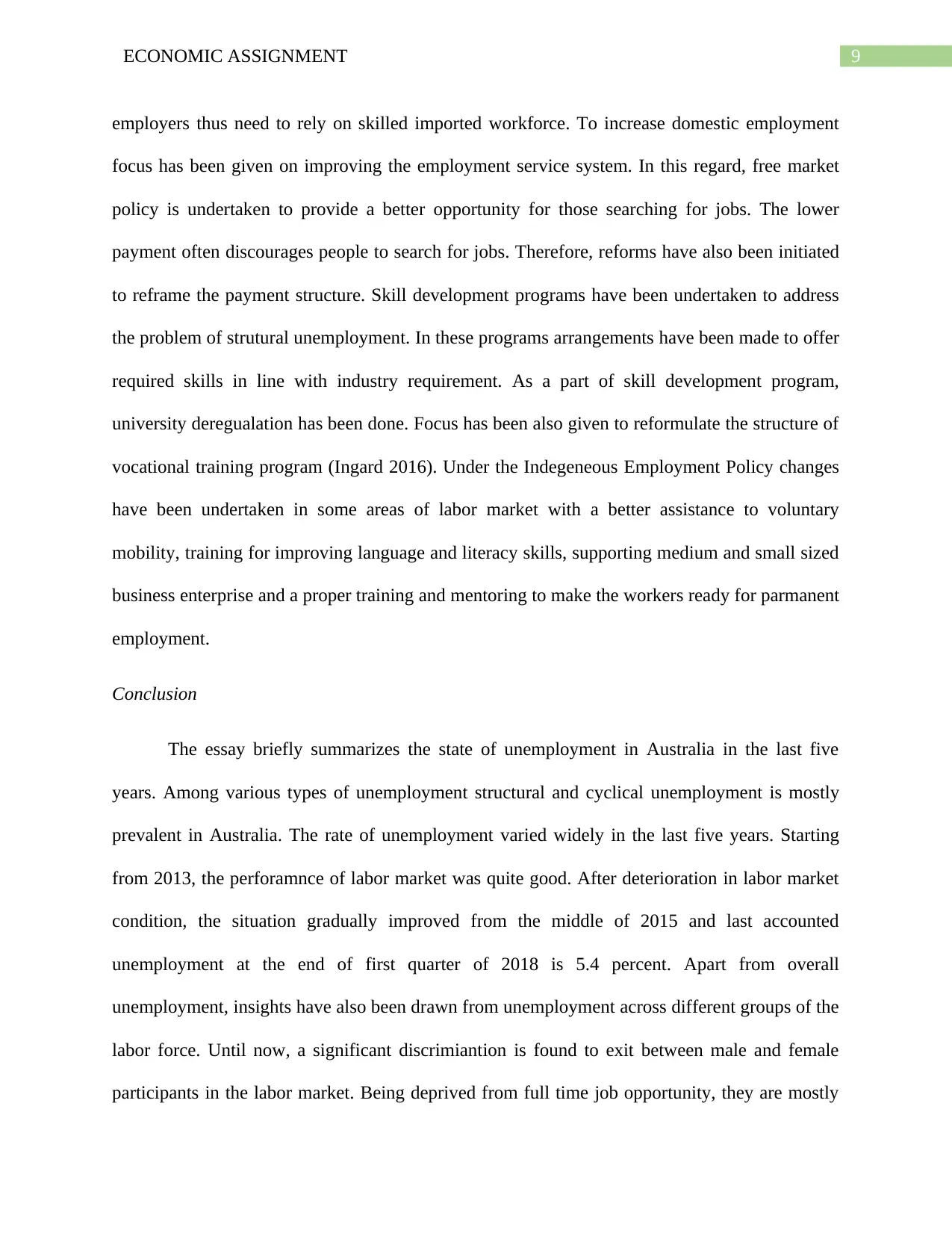
9ECONOMIC ASSIGNMENT
employers thus need to rely on skilled imported workforce. To increase domestic employment
focus has been given on improving the employment service system. In this regard, free market
policy is undertaken to provide a better opportunity for those searching for jobs. The lower
payment often discourages people to search for jobs. Therefore, reforms have also been initiated
to reframe the payment structure. Skill development programs have been undertaken to address
the problem of strutural unemployment. In these programs arrangements have been made to offer
required skills in line with industry requirement. As a part of skill development program,
university deregualation has been done. Focus has been also given to reformulate the structure of
vocational training program (Ingard 2016). Under the Indegeneous Employment Policy changes
have been undertaken in some areas of labor market with a better assistance to voluntary
mobility, training for improving language and literacy skills, supporting medium and small sized
business enterprise and a proper training and mentoring to make the workers ready for parmanent
employment.
Conclusion
The essay briefly summarizes the state of unemployment in Australia in the last five
years. Among various types of unemployment structural and cyclical unemployment is mostly
prevalent in Australia. The rate of unemployment varied widely in the last five years. Starting
from 2013, the perforamnce of labor market was quite good. After deterioration in labor market
condition, the situation gradually improved from the middle of 2015 and last accounted
unemployment at the end of first quarter of 2018 is 5.4 percent. Apart from overall
unemployment, insights have also been drawn from unemployment across different groups of the
labor force. Until now, a significant discrimiantion is found to exit between male and female
participants in the labor market. Being deprived from full time job opportunity, they are mostly
employers thus need to rely on skilled imported workforce. To increase domestic employment
focus has been given on improving the employment service system. In this regard, free market
policy is undertaken to provide a better opportunity for those searching for jobs. The lower
payment often discourages people to search for jobs. Therefore, reforms have also been initiated
to reframe the payment structure. Skill development programs have been undertaken to address
the problem of strutural unemployment. In these programs arrangements have been made to offer
required skills in line with industry requirement. As a part of skill development program,
university deregualation has been done. Focus has been also given to reformulate the structure of
vocational training program (Ingard 2016). Under the Indegeneous Employment Policy changes
have been undertaken in some areas of labor market with a better assistance to voluntary
mobility, training for improving language and literacy skills, supporting medium and small sized
business enterprise and a proper training and mentoring to make the workers ready for parmanent
employment.
Conclusion
The essay briefly summarizes the state of unemployment in Australia in the last five
years. Among various types of unemployment structural and cyclical unemployment is mostly
prevalent in Australia. The rate of unemployment varied widely in the last five years. Starting
from 2013, the perforamnce of labor market was quite good. After deterioration in labor market
condition, the situation gradually improved from the middle of 2015 and last accounted
unemployment at the end of first quarter of 2018 is 5.4 percent. Apart from overall
unemployment, insights have also been drawn from unemployment across different groups of the
labor force. Until now, a significant discrimiantion is found to exit between male and female
participants in the labor market. Being deprived from full time job opportunity, they are mostly
Paraphrase This Document
Need a fresh take? Get an instant paraphrase of this document with our AI Paraphraser
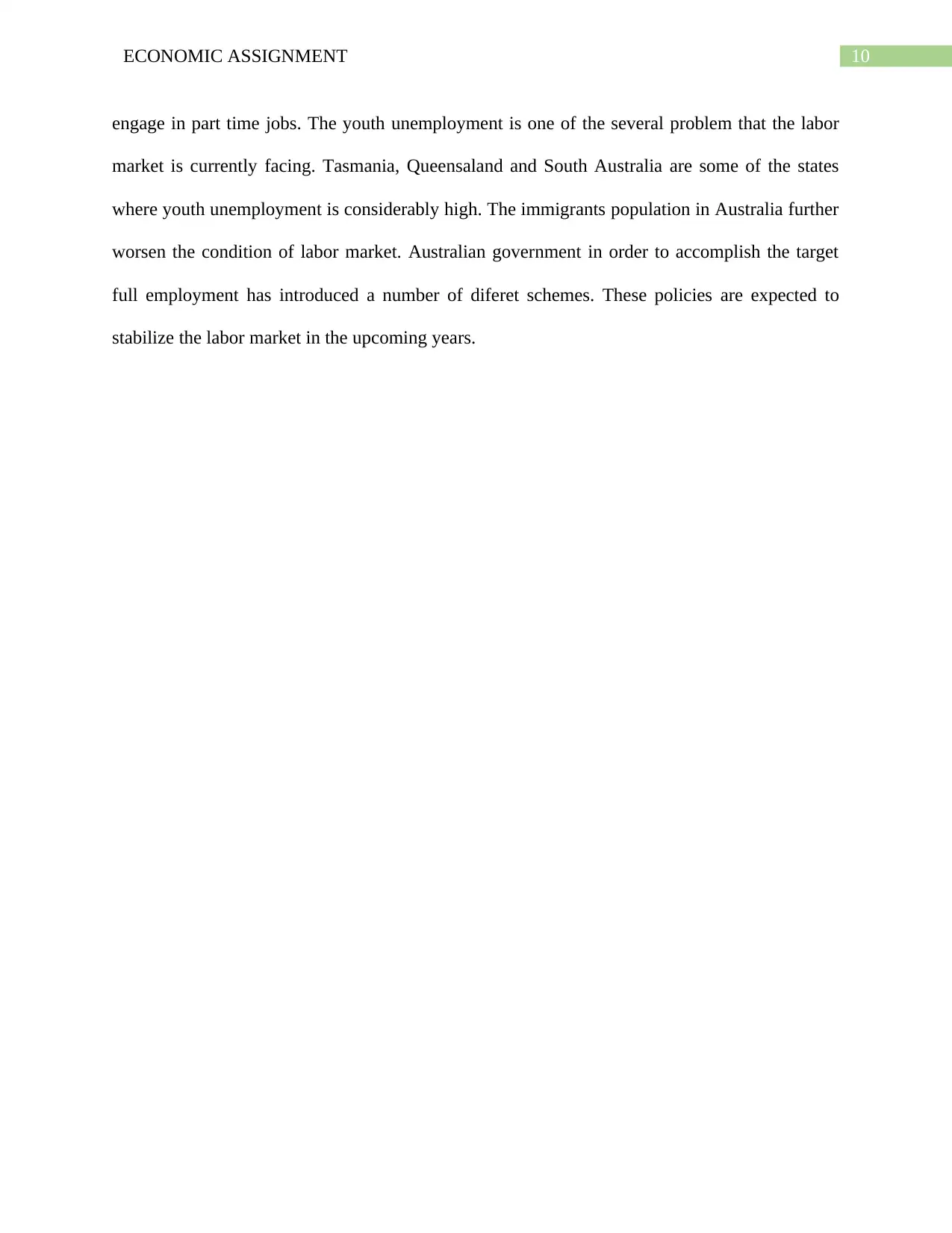
10ECONOMIC ASSIGNMENT
engage in part time jobs. The youth unemployment is one of the several problem that the labor
market is currently facing. Tasmania, Queensaland and South Australia are some of the states
where youth unemployment is considerably high. The immigrants population in Australia further
worsen the condition of labor market. Australian government in order to accomplish the target
full employment has introduced a number of diferet schemes. These policies are expected to
stabilize the labor market in the upcoming years.
engage in part time jobs. The youth unemployment is one of the several problem that the labor
market is currently facing. Tasmania, Queensaland and South Australia are some of the states
where youth unemployment is considerably high. The immigrants population in Australia further
worsen the condition of labor market. Australian government in order to accomplish the target
full employment has introduced a number of diferet schemes. These policies are expected to
stabilize the labor market in the upcoming years.
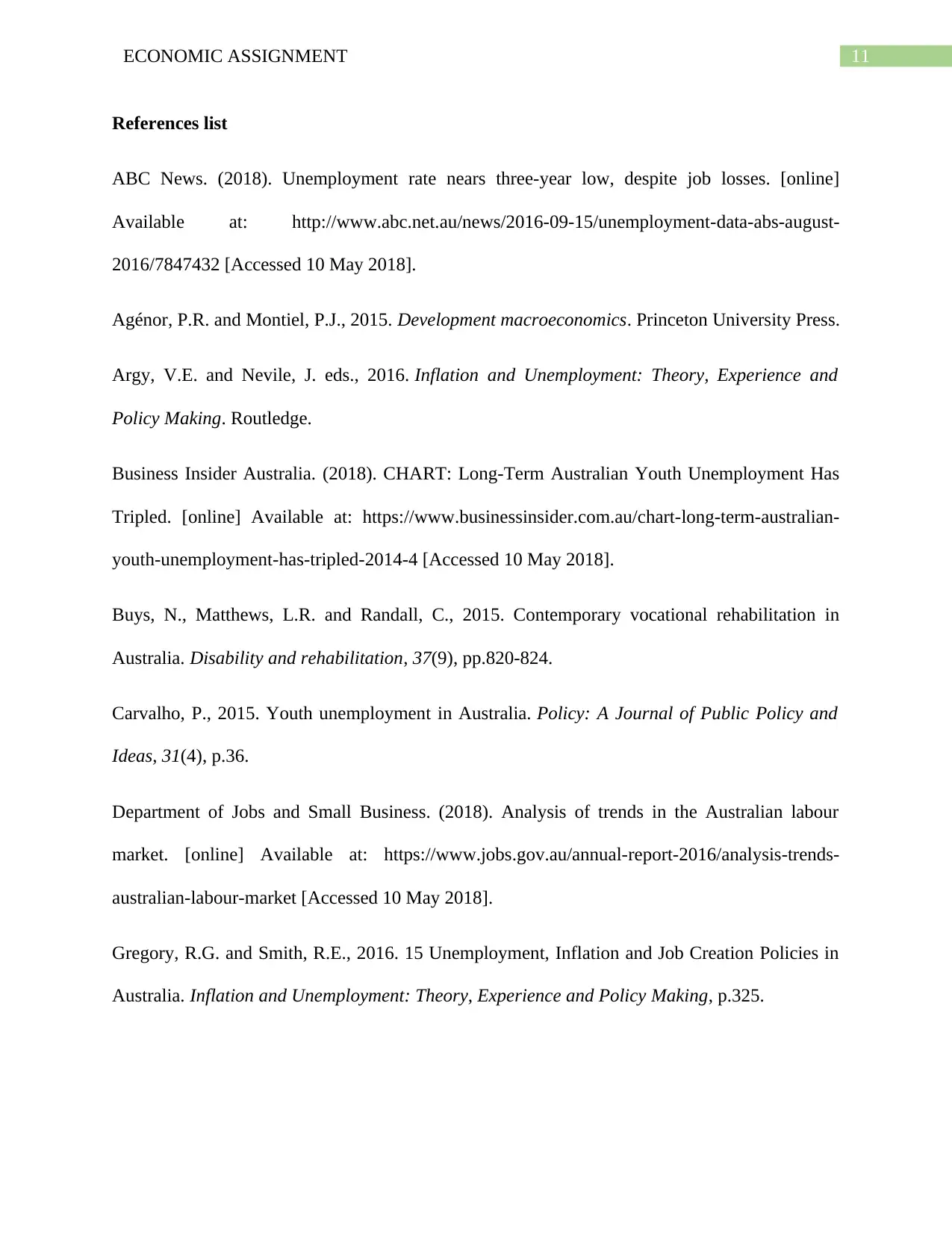
11ECONOMIC ASSIGNMENT
References list
ABC News. (2018). Unemployment rate nears three-year low, despite job losses. [online]
Available at: http://www.abc.net.au/news/2016-09-15/unemployment-data-abs-august-
2016/7847432 [Accessed 10 May 2018].
Agénor, P.R. and Montiel, P.J., 2015. Development macroeconomics. Princeton University Press.
Argy, V.E. and Nevile, J. eds., 2016. Inflation and Unemployment: Theory, Experience and
Policy Making. Routledge.
Business Insider Australia. (2018). CHART: Long-Term Australian Youth Unemployment Has
Tripled. [online] Available at: https://www.businessinsider.com.au/chart-long-term-australian-
youth-unemployment-has-tripled-2014-4 [Accessed 10 May 2018].
Buys, N., Matthews, L.R. and Randall, C., 2015. Contemporary vocational rehabilitation in
Australia. Disability and rehabilitation, 37(9), pp.820-824.
Carvalho, P., 2015. Youth unemployment in Australia. Policy: A Journal of Public Policy and
Ideas, 31(4), p.36.
Department of Jobs and Small Business. (2018). Analysis of trends in the Australian labour
market. [online] Available at: https://www.jobs.gov.au/annual-report-2016/analysis-trends-
australian-labour-market [Accessed 10 May 2018].
Gregory, R.G. and Smith, R.E., 2016. 15 Unemployment, Inflation and Job Creation Policies in
Australia. Inflation and Unemployment: Theory, Experience and Policy Making, p.325.
References list
ABC News. (2018). Unemployment rate nears three-year low, despite job losses. [online]
Available at: http://www.abc.net.au/news/2016-09-15/unemployment-data-abs-august-
2016/7847432 [Accessed 10 May 2018].
Agénor, P.R. and Montiel, P.J., 2015. Development macroeconomics. Princeton University Press.
Argy, V.E. and Nevile, J. eds., 2016. Inflation and Unemployment: Theory, Experience and
Policy Making. Routledge.
Business Insider Australia. (2018). CHART: Long-Term Australian Youth Unemployment Has
Tripled. [online] Available at: https://www.businessinsider.com.au/chart-long-term-australian-
youth-unemployment-has-tripled-2014-4 [Accessed 10 May 2018].
Buys, N., Matthews, L.R. and Randall, C., 2015. Contemporary vocational rehabilitation in
Australia. Disability and rehabilitation, 37(9), pp.820-824.
Carvalho, P., 2015. Youth unemployment in Australia. Policy: A Journal of Public Policy and
Ideas, 31(4), p.36.
Department of Jobs and Small Business. (2018). Analysis of trends in the Australian labour
market. [online] Available at: https://www.jobs.gov.au/annual-report-2016/analysis-trends-
australian-labour-market [Accessed 10 May 2018].
Gregory, R.G. and Smith, R.E., 2016. 15 Unemployment, Inflation and Job Creation Policies in
Australia. Inflation and Unemployment: Theory, Experience and Policy Making, p.325.
⊘ This is a preview!⊘
Do you want full access?
Subscribe today to unlock all pages.

Trusted by 1+ million students worldwide
1 out of 14
Related Documents
Your All-in-One AI-Powered Toolkit for Academic Success.
+13062052269
info@desklib.com
Available 24*7 on WhatsApp / Email
![[object Object]](/_next/static/media/star-bottom.7253800d.svg)
Unlock your academic potential
Copyright © 2020–2025 A2Z Services. All Rights Reserved. Developed and managed by ZUCOL.




